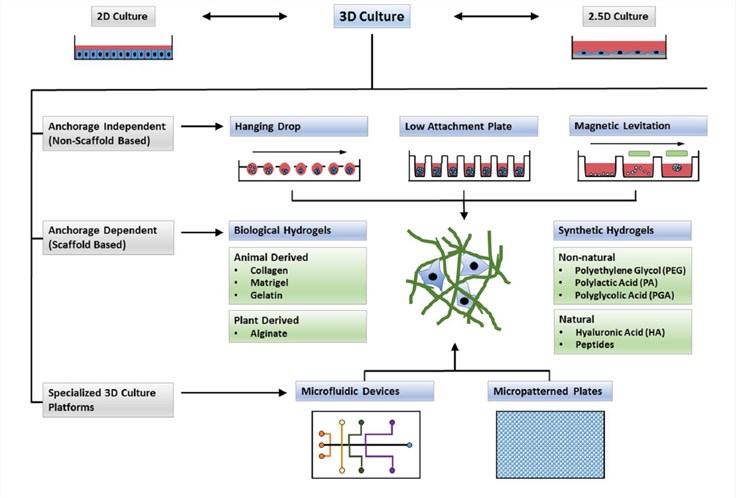NASH Model 3D Multicellular Organoid Culture Service
The construction of human 3D microtissue organoids for use in toxicity and functional assays could bridge the gap between currently accepted in vitro cell culture models and in vivo functional analyses. The technology should enable superior insights in mechanisms underlying full maturation of different cells within these tissues to enable drug screens, drug toxicity (and metabolization) studies. Creative Biolabs is a pioneer in the development of novel in vivo-like 3D models of NASH to help you with better research and treatment for NASH.
Introduction of 3D Cell Cultures
In vivo cells undergo a complex three-dimensional (3D) environment that exposes them to circulating molecules, adjacent cells and the extracellular matrices (ECMs). 3D cell culture focuses on mimicking normal cell-matrix and cell-cell interactions to form discrete tissue and organ structures. Although most cell culture studies are performed by growing cells on a two-dimensional (2D) flat, glass or plastic plane that is suitable for many detection and imaging instrument protocols, it clearly does not fully mimic the 3D cellular environment in vivo. Therefore, 3D cell culture is considered an emerging field with high interest because it provides a better predictive in vitro model to study basic cell biology, disease pathophysiology and identification of novel therapeutic agents. 3D cell culture technology has evolved into many cell types including hepatocytes, muscle cells, and neurons. It may be more widely used to analyze the high wear rate of compounds entering clinical evaluation using 3D culture-based assays.
 Fig.1 Types of 3D cultures. (Langhans, 2018)
Fig.1 Types of 3D cultures. (Langhans, 2018)
Introduction of 3D Multicellular Organoid Cultures
An ideal 3D culture model will mimic tissue-specific, physiological or pathophysiological disease-specific microenvironments, where cells can proliferate, aggregate and differentiate. Such models will include cell-cell and cell-ECM interactions, tissue-specific hardness, oxygen, nutrient, and metabolic waste gradients, and combinations of tissue-specific scaffold cells. Many 3D culture techniques use spheroids or organoids. In practice, most 3D cell models have a minimum depth of 50 μm and have a matrix and structure. A more complex model is a type of organoid that is a 3D micro-organ bud cultured in vitro that exhibits true microscopic anatomy. Organoids are divided into tissue and stem cell organs, the former having stromal cell-free (or mesenchymal) cultures. Alternatively, human stem cell organoids are produced by stem cells, wherein the 3D cellular environment can significantly affect cell differentiation and organoid formation.
The Role of 3D Multicellular Organoid Cultures in NASH
Studying the molecular mechanisms of steatosis and the consequences of hepatocyte accumulation of triglycerides may be important for understanding the transition from steatosis to NASH and developing new therapeutic interventions. But recapitulating this disease is very difficult because it involves many types of liver cells. Therefore, this complex disease requires preclinical models with biological relevance and robustness that can simulate all of these influencing factors. In vitro models of NASH range from simple cell-based culture systems exposed to various lipids and cytokines to more complex models based on 3D multicellular organoid cultures with or without perfusion of simulated sinusoidal blood flow. A variety of methods, including layered co-culture, spheroids, micropatterned surfaces, human precision cut sections, and bioprinting, have been used to develop such 3D cultures to replicate the structure of the intact liver. Creative Biolabs has developed a fully humanized in vitro NASH model using the 3D multicellular organoid cultures platform, which outlines many of the features of clinical NASH and is an ideal tool for analyzing the efficacy of anti-fatty denatured compounds.
Creative Biolabs continues to support you with a diverse and evolving portfolio of innovative 3D cell culture products of NASH, as well as workflow solutions, protocols, and expertise. Besides the products or services for preclinical models of NASH, if you want to receive the latest 3D cell culture resources and news, please feel free to contact us for more details.
Reference
- Langhans, S.A. Three-dimensional in vitro cell culture models in drug discovery and drug repositioning. Frontiers in Pharmacology. 2018, 9: 6. Distributed under Open Access license CC BY 4.0, without modification.
 For Research Use Only.
For Research Use Only.